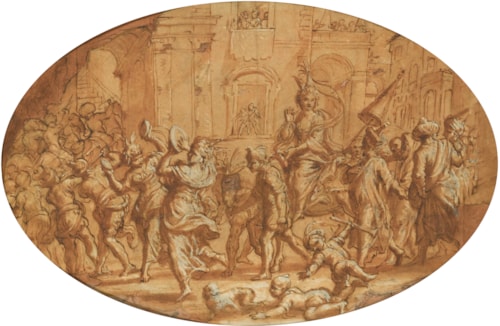acob Cats
(Altona 1741 - Amsterdam 1799)
Winter Landscape with Peasants with a Sledge by a Farm, a Town Beyond
signed, dated, and numbered in brown ink ‘664 / J: Cats Ao 1795’ (verso)
black chalk and grey and brown wash, and touches of white heightening, within brown ink framing lines
27.2 x 35.9 cm (10⅝ x 14 in)
In its large-scale, atmospheric subject matter and fine execution, Winter Landscape with Peasants with a Sledge by a Farm, a Town Beyond is an outstanding drawing by Jacob Cats. Cats was a leading draughtsman and watercolourist in late eighteenth-century Holland, a reputation confirmed by his engaging and highly detailed studies, a further example of which can be found in catalogue number 129. In the present work, the figures treading across the landscape, the undulating snow-covered roofs of the houses and the bare trees and darkening clouds, exemplify Cats’ talent for pictorial expression.
Of particular interest in this drawing is the numbering on the verso, which is in the artist’s own hand. According to Jane Shoaf Turner, between a quarter and a third of his drawings have such numbers, and the works are predominately less finished monochromatic sketches, either in black chalk or with grey wash, such as this work.¹ Turner suggests that the numbered drawings may have been used to assemble a pattern or sample book, from which potential clients could select compositions or motifs that they would like worked up into finished drawings and watercolours. In the present case, there exists a watercolour of the same subject painted by Cats in the same year (Private collection). The two versions differ somewhat in the representation of the trees and the positioning of the background staffage but are virtually identical. The upright figure by the sledge, which has been erased but is still just visible in the drawing, does not appear in the watercolour.
A drawing by Cats depicting the Papeneiland in Amsterdam also depicts figures pulling and pushing a sledge with a dog following behind, a motif that bears a marked resemblance to that in this drawing. This is further evidence that Cats reused his most popular motifs, thereby contributing to his artistic prolificacy and commercial success.
¹ Turner, J.S., 'Jacob Cats and the Identification of a "Pseudo-Goll van Franckenstein" Numbering System', in Master Drawings, XXVIII, no. 3 (Autumn 1990), pp. 323-331. See also Leslie A. Schwarz, op. cit., pp. 57-77.
Sale, Amsterdam, Sotheby Mak van Waay, 2 May 1984, lot 22;
sale, Amsterdam, Christie's, 18 November 1985, lot 156;
Jacobus A. Klaver, Amsterdam
L.A. Schwartz, 'The 'Thoughts' ('Gedagten') of Jacob Cats (1741-1799). Inscriptions on the numbered drawings of a prolific eighteenth-century draughtsman. An addition to the list of Jane Shoaf Turner (1990),' in Delineavit et Sculpsit, 31 (December 2007), p. 73
In its large-scale, atmospheric subject matter and fine execution, Winter Landscape with Peasants with a Sledge by a Farm, a Town Beyond is an outstanding drawing by Jacob Cats. Cats was a leading draughtsman and watercolourist in late eighteenth-century Holland, a reputation confirmed by his engaging and highly detailed studies, a further example of which can be found in catalogue number 129. In the present work, the figures treading across the landscape, the undulating snow-covered roofs of the houses and the bare trees and darkening clouds, exemplify Cats’ talent for pictorial expression.
Of particular interest in this drawing is the numbering on the verso, which is in the artist’s own hand. According to Jane Shoaf Turner, between a quarter and a third of his drawings have such numbers, and the works are predominately less finished monochromatic sketches, either in black chalk or with grey wash, such as this work.¹ Turner suggests that the numbered drawings may have been used to assemble a pattern or sample book, from which potential clients could select compositions or motifs that they would like worked up into finished drawings and watercolours. In the present case, there exists a watercolour of the same subject painted by Cats in the same year (Private collection). The two versions differ somewhat in the representation of the trees and the positioning of the background staffage but are virtually identical. The upright figure by the sledge, which has been erased but is still just visible in the drawing, does not appear in the watercolour.
A drawing by Cats depicting the Papeneiland in Amsterdam also depicts figures pulling and pushing a sledge with a dog following behind, a motif that bears a marked resemblance to that in this drawing. This is further evidence that Cats reused his most popular motifs, thereby contributing to his artistic prolificacy and commercial success.
¹ Turner, J.S., 'Jacob Cats and the Identification of a "Pseudo-Goll van Franckenstein" Numbering System', in Master Drawings, XXVIII, no. 3 (Autumn 1990), pp. 323-331. See also Leslie A. Schwarz, op. cit., pp. 57-77.
Sale, Amsterdam, Sotheby Mak van Waay, 2 May 1984, lot 22;
sale, Amsterdam, Christie's, 18 November 1985, lot 156;
Jacobus A. Klaver, Amsterdam
L.A. Schwartz, 'The 'Thoughts' ('Gedagten') of Jacob Cats (1741-1799). Inscriptions on the numbered drawings of a prolific eighteenth-century draughtsman. An addition to the list of Jane Shoaf Turner (1990),' in Delineavit et Sculpsit, 31 (December 2007), p. 73





 contact
contact contact
contact +44 20 7313 8040
+44 20 7313 8040









